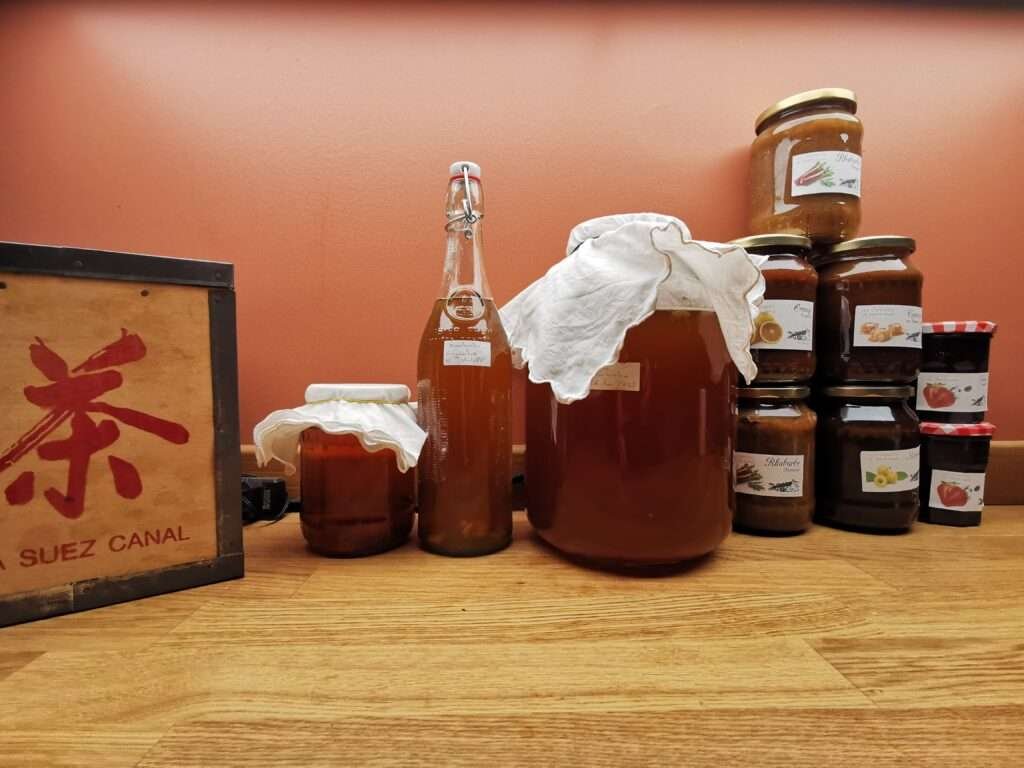This website uses cookies so that we can provide you with the best user experience possible. Cookie information is stored in your browser and performs functions such as recognising you when you return to our website and helping our team to understand which sections of the website you find most interesting and useful.
Kombucha is made from a symbiotic culture of bacteria and yeast (SCOBY) that transforms sugar and tea into acids, carbon dioxide and small amounts of alcohol. This fermentation creates an effervescent drink with a sweet and sour taste, with variations possible depending on the type of tea used, the ingredients added during fermentation, and the length of fermentation. Today, Kombucha is often appreciated not only for its unique taste, but also for its potential health benefits, linked to its probiotic content and other (unconfirmed) bioactive compounds. Be warned, however, that making kombucha requires great care and attention to hygiene.
Ingredients
Ingredients for 1 litre of kombucha
(multiply by the number of litres in your jar):
- 1 litre water
- 8g black tea
- 80 grams sugar (preferably white sugar, avoid honey or raw sugar)
- A ‘mother’ of kombucha (called SCOBY – Symbiotic Culture Of Bacteria and Yeast) which you can find as a gift on the internet or buy in organic shops.
- 10 cl (10%) of already fermented kombucha (can be bought in bottles or come from previous production)
Equipment:
- A large 3-5 litre glass container (non-metallic, open) for fermentation
- A piece of cloth or paper towel to cover the container
- A rubber band to secure the cloth to the container
- Pressure-resistant glass lemonade bottles for storing the fermented Kombucha
Recipe
Steps :
- Preparing the tea:
- Bring the water to the boil.
- Add the tea and leave to infuse for at least 15 minutes.
- Add the sugar, stirring until it has completely dissolved.
- To cool:
- Allow to cool to room temperature. Make sure the mixture has cooled completely before moving on to the next step.
- Inoculation :
- Pour the cooled tea into the fermentation container.
- Add the SCOBY (or Kombucha mother) and the starter (already fermented Kombucha).
- Primary fermentation :
- Cover the container with the cloth or paper towel and secure with a rubber band.
- Place the container in a dark place at room temperature (ideally between 20 and 30 degrees Celsius).
- Leave to ferment for 7 to 14 days, depending on your taste preferences.
- Taste and test:
- Taste your kombucha after a few days to check that it has reached the desired level of fermentation. The more it ferments, the more acidic it will be, and it should smell slightly vinegary and fizz a little in the mouth.
- When you’re satisfied with the taste, set aside the SCOBY and 12 cl of drink for the next batch.
- Bottling :
- Bottle the rest of the kombucha in glass bottles using a strainer, leaving an air space (so they don’t burst).
- You can add flavours (fruit, herbs, spices) at this stage if you wish.
- Second fermentation :
- Close the bottles and leave them to ferment at room temperature for 3 to 7 days. This will help the bubbles to develop.
- Chilling :
- Put the bottles in the fridge to slow down fermentation. This will make the kombucha ready to drink and more palatable.
Our current flavour trial is ginger violet syrup… You can adjust the proportions according to the quantity of kombucha you wish to produce.
Don’t forget to follow strict hygiene practices throughout the process to avoid any unwanted contamination (it’s recommended to wash your hands and then wash them with edible white vinegar).

and Kombucha undergoing first fermentation
Historical background:
The history of kombucha goes back thousands of years, and its exact origins remain somewhat obscure. However, the drink is thought to have been discovered in China and then introduced to other parts of Asia and Europe over the centuries. Here’s a brief history of kombucha:
- Ancient China: The first mentions of kombucha date back to ancient China, where the drink was nicknamed “immortality tea”. It is said that kombucha was consumed for medicinal purposes and was associated with various health benefits.
- Silk Road: The popularity of kombucha is said to have followed the Silk Road, an ancient trade route linking China to Europe. Traders and travellers would have brought this fermented drink with them, helping to spread it to other regions.
- Russia and Eastern Europe: Over time, kombucha would have reached Russia and other parts of Eastern Europe. It was incorporated into various culinary and medicinal traditions in these regions.
- Reappearance in the 20th century: Kombucha went through a period of relative obscurity for a while, but resurfaced during the 20th century. It became more widely known in the 1960s and 1970s, thanks in particular to the hippy counterculture and alternative health movements.
- Global popularity: Kombucha has grown in popularity around the world in recent decades, particularly as a result of the growing popularity of fermented foods and probiotic drinks. It has become a commercial product, available in many health food shops and supermarkets.



